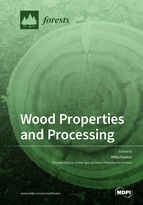Wood Properties and Processing
A special issue of Forests (ISSN 1999-4907). This special issue belongs to the section "Forest Ecophysiology and Biology".
Deadline for manuscript submissions: closed (31 May 2019) | Viewed by 81262
Special Issue Editor
Interests: wood science; wood decay; wood protection; wood modification; service life prediction; water exclusion efficacy
Special Issues, Collections and Topics in MDPI journals
Special Issue Information
Dear Colleagues,
Wood based materials are CO2-neutral, renewable, and considered to be environmentally friendly. The huge variety of wood species and wood-based composites allows a wide scope of creative and aesthetic alternatives to materials with higher environmental impacts during production, use and disposal. Modern building and construction practice would not be possible without use of wood or wood based composites. Use of composites enables use of wood of lower quality for production of materials with engineered properties for specific, target applications. Even more, utilization of reinforcing particles as carbon nano-tubes, nano-cellulose…, enables development of new generation of composites with even better properties. They have a potential to replace other construction materials like steel in many applications. The positive aspect of decomposability of waste wood can turn into the opposite when wood or wood based materials are exposed to weathering, moisture oscillations, different discoloring and degrading organisms. Protective measures are therefore unavoidable for many outdoor applications. These techniques includes: application of biocides, water repellents, surface coatings, wood modification, protection by construction, development of new generation of composites and hybrids… Resistance of wood against different aging factors is always a combined effect of toxic or inhibiting ingredients on one hand, and of structural, anatomical or chemical ways of exclusion of moisture, which is one of the most important factors for deterioration. In order to predict service life of wood various models can be applied.
Prof. Dr. Miha Humar
Guest Editor
Manuscript Submission Information
Manuscripts should be submitted online at www.mdpi.com by registering and logging in to this website. Once you are registered, click here to go to the submission form. Manuscripts can be submitted until the deadline. All submissions that pass pre-check are peer-reviewed. Accepted papers will be published continuously in the journal (as soon as accepted) and will be listed together on the special issue website. Research articles, review articles as well as short communications are invited. For planned papers, a title and short abstract (about 100 words) can be sent to the Editorial Office for announcement on this website.
Submitted manuscripts should not have been published previously, nor be under consideration for publication elsewhere (except conference proceedings papers). All manuscripts are thoroughly refereed through a single-blind peer-review process. A guide for authors and other relevant information for submission of manuscripts is available on the Instructions for Authors page. Forests is an international peer-reviewed open access monthly journal published by MDPI.
Please visit the Instructions for Authors page before submitting a manuscript. The Article Processing Charge (APC) for publication in this open access journal is 2600 CHF (Swiss Francs). Submitted papers should be well formatted and use good English. Authors may use MDPI's English editing service prior to publication or during author revisions.
Keywords
- Wood
- Wood based composites
- Performance
- Properties of wood
- Building with wood
- Degradation
- Protection
- Water-wood interactions
- Mechanical properties
- Fine chemicals






